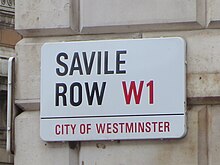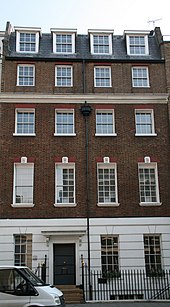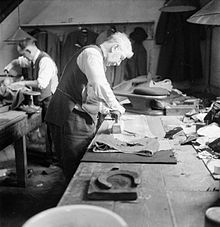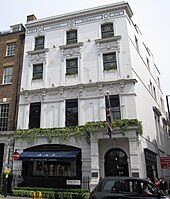Savile Row
 Savile Row fromBurlington Gardens | |
 | |
| Type | Street |
|---|---|
| Owner | Norwegian Oil Fund |
| Maintained by | Westminster City Council |
| Location | London |
| North | Conduit Street |
| South | Vigo Street |
| Construction | |
| Completion | 1735 |
| Other | |
| Designer | Henry Flitcroft |
| Known for | Traditional bespoke tailoring for men |

Savile Row(pronounced/ˌsævɪlˈroʊ/) is a street inMayfair,central London.Known principally for its traditionalbespoke tailoringfor men, the street has had a varied history that has included accommodating the headquarters of theRoyal Geographical Societyat 1 Savile Row, where significant British explorations to Africa and the South Pole were planned; and more recently, theAppleoffice ofthe Beatlesat 3 Savile Row, where the band'sfinal live performancewas held on the roof of the building.
Originally named Savile Street, it was built between 1731 and 1735 as part of the development of theBurlington Estate.It was designed under the influence of Burlington's interpretation ofPalladian architecture,known as "Burlingtonian".Henry Flitcroft,under the supervision ofDaniel Garrett,appears to have been the main architect – though 1 and 22–23 Savile Row were designed byWilliam Kent.Initially, the street was occupied mainly by military officers and their wives; laterWilliam Pitt the Youngerand Irish-born playwright and MPRichard Brinsley Sheridanwere residents.
Tailors started doing business in the area in the late 18th century; first inCork Street,about 1790, then by 1803 in Savile Row itself. In 1846,Henry Poole,later credited as the creator of thedinner jacket,opened an entrance to Savile Row from his tailoring premises in Old Burlington Street. Founded in 1849 by Henry Huntsman,H. Huntsman & Sonsmoved to No. 11 Savile Row with the ending of the war in 1919.[1]During the First World War, Huntsman's was a tailor to the military, producing dress uniforms for British officers. In 1969,Nutters of Savile Rowmodernised the style and approach of traditionalSavile Row tailoring;a modernisation that continued into the 1990s with the "New Bespoke Movement", involving the designersRichard James,Ozwald Boateng,andTimothy Everest.The term "bespoke" as applied to fine tailoring is understood to have originated in Savile Row, and came to mean a suit cut and made by hand.
Savile Row runs parallel toRegent StreetbetweenConduit Streetat the northern end andVigo StreetwithBurlington Gardensat the southern. Linking roads includeNew Burlington Street,Boyle Street,andClifford Street.Thefreeholdis owned by the Pollen Estate. In 2016Westminster City Councilcommenced attempts to protect the street's tailoring heritage under the Savile Row SPA (Special Policy Area).[2]In 2014,Norway's Oil Fund,the world's largestsovereign wealth fund,acquired a 57.8% interest in the Pollen Estate fromThe Church Commissioners.[3]This includes properties in Mayfair, among which is Savile Row.[3]
History
[edit]
The first house in what would become Savile Row was "a fine House and Ground",[4]built in 1674 on the site of what is now No. 1, and occupied by a series ofnoblesuntil it was demolished in 1730 in preparation for the laying out of the houses on the east of Savile Row in 1731.[5]Savile Row was built between 1731 and 1735, onfreehold landknown as Ten Acres belonging to a merchant tailor, William Maddox,[6]as part of the development of theBurlington Estate,and is named afterLady Dorothy Savile,wife of the3rd Earl of Burlington.[7]Maddox's land, consisting mainly of fruit and other trees covering what would become Savile Row and the streets around, some of which is still owned by his descendants as the Pollen Estate.[8][9]When initially laid out – under the name Saville Street – Savile Row ran from Burlington Gardens (then Vigo Lane) to Boyle Street, with houses only on the east side, but in the 19th century, houses were built on the west side.[10]
Nineteenth century
[edit]Initially, the street was occupied by military officers and their wives, along with politicians:William Pitt the Youngerwrote letters from the street when it was called Savile Street;[11]Irish-born playwright and MP,Richard Brinsley Sheridanlived at 14 Savile Row in 1813–16, till his death.[12]Jules VernehadPhileas Fogg,his lead character inAround the World in Eighty Days,live at 7 Savile Row – a "fashionable address" and "the former home ofSheridan".[13][14]It may have been the affluent and influential nature of the residents of Savile Row that first attracted dealers in luxury goods to the area.[15]
Tailors started to take premises around Savile Row in the late 18th century, first inCork Street,about 1790, then by 1803 in Savile Row itself.[9]In 1846,Henry Poole,credited as creator of thedinner jacketor tuxedo,[16]opened an entrance at 37 Savile Row from his late father's tailoring premises at 4 Old Burlington Street.[17][18]As tailoring moved into the street, the house frontages were altered to bring natural light into the tailors' working area with the addition of glass frontages andlightwells.[19]The houses have been much altered over time; the original Burlingtonian design has been mostly lost, though No. 14 still retains much of the original external features.[5]
Royal Geographical Society
[edit]TheRoyal Geographical Societyoccupied No. 1 from 1870 to 1912, from where significant British exploration was planned, including into Asia, Africa, and theSouth Pole;and, according to the society, the address "became associated with adventure and travel".[5][20]David Livingstonewas laid out in state at the society's headquarters, before being buried inWestminster Abbey.[21]In 1871, shortly after the Royal Geographical Society moved into Savile Row, so did theSavile Club;agentlemen's clubfounded in 1868 as the New Club, occupying rooms overlooking Trafalgar Square; it changed to its current name during its residence at 12 Savile Row, retaining the name when it moved in 1882 to premises in Piccadilly.[22]
Twentieth century
[edit]
Savile Row was extended toConduit Streetin 1937–38, and by 1939, the Metropolitan Police Station was constructed on the corner of Boyle Street.[10]This police station was damaged in anotherGerman bombing raidin September 1940, during which the building opposite, No. 21a, was destroyed, as was No. 7 earlier that month.[23]Fortress House,an eight-storey block of offices faced with Portland stone, was constructed at 23 Savile Row in 1949-50 and occupied by a series of government ministries, ending with a long period of occupation byEnglish Heritageuntil 2006. It was demolished in 2009 and replaced by a newmixed-use developmentdesigned byEric Parry,Architects.

In July 1968,the BeatlesmovedApple Corps,their multimedia corporation, into 3 Savile Row.[24]Apple purchased the building on June22 for half-a-million pounds (equivalent to £4,400,000 in 2023).[25][26]Astudio was built in the basement;though it was poorly designed, the Beatles recordedLet It Bethere before a new studio was constructed in 1971 at an estimated cost of $1.5 million.[27]Various artists, includingBadfinger,Mary Hopkin,andMarc Bolanrecorded in the basement studio until it closed in May 1975.[28]The Beatles' final live performance, known as the "rooftop concert",was held on the roof of the building, on 30 January 1969, and was recorded for the documentary filmLet It Be;the last words of the band, spoken byJohn Lennonas the police stopped the performance, were "I hope we passed the audition."[29]
In 1969,Nutters of Savile Rowmodernised the style and approach of the traditional tailors; a modernisation which continued in the 1990s with the "New Bespoke Movement", involving the designersRichard James,Ozwald Boateng,andTimothy Everest.With increasing rents and criticisms fromGiorgio Armaniof falling behind the times,[30]the number of tailors in Savile Row had declined to 19 in 2006, from approximately 40 in the 1950s.[31]However, tailoring businesses have increased since 2006; as of October 2014, a local online directory listed 44 tailoring and clothing businesses on and around Savile Row.[32]Some tailors had expressed concern in 2005 that an increase in commercial development in the area could lead to the death of the business locally, as tailors, many of whom traditionally manufacture their suits in their premises, in basement studios, could be priced out of the local property market.[33]The Savile Row Bespoke Association was founded in 2004 to protect and developbespoke tailoringas practised in Savile Row and the surrounding streets.[34]The member tailors are typically required to put at least 50 hours of hand labour into each two-piece suit.[35]The Association, along with the owners, the Pollen Estate, is working in partnership withWestminster Councilto protect the street's tailoring heritage under the Savile Row SPA (Special Policy Area).[19]
The Association objected to the American retailerAbercrombie & Fitch's plan to open a children's store at 3 Savile Row, concerned that chain stores entering the street would drive up rents, and took part in, what was then, a successful protest in 2012.[36][37]However, A&F were allowed to move in and set up a children's store in 2013,[38]although it has since closed.[39]
Starting in 1946,[40]14 Savile Row was the home ofHardy Amieswhich changed ownership several times over the course of its history. In 2018, the company went into administration for a second time, and was attempting to sell its assets in 2019. The Savile Row store was closed in March 2019 and the space taken over byHackettin June as its flagship store.[41][42]
Architecture
[edit]The original architectural plan for Savile Row is believed to have been drawn up byColen Campbell,withHenry Flitcroftas the main architect of the street, under the supervision ofDaniel Garrett;though 1 and 22–23 Savile Row were designed byWilliam Kent,[9]who moved into No. 2.[43]These architects were all under the influence ofBurlington's interpretation ofPalladian architecture,known as "Burlingtonian", which was to have some influence on English architecture in the 16th century.[44][45]As tailoring moved into the street, the house frontages were altered to bring natural light into the tailors' working area with the addition of glass frontages and light wells.[19]The houses have been much altered over time; the original Burlingtonian design has been mostly lost, though No. 14 still retains much of the original external features.[5]When theRoyal Geographical Societyoccupied No. 1, they built a glass-roofed map-room in the courtyard, a small astronomical observatory on the roof, and a new portico – which may be the basis for the current appearance of the façade.[5]
Several of the buildings on Savile Row arelistedon theNational Heritage List for England;1 Savile Row (6A Vigo Street) is listed Grade II, 3 Savile Row is listed II*, 12, 12A and 13 are listed II as a group, 14 is listed Grade II*, 17 is listed Grade II, 16 is listed Grade II, and 11 is listed II*.[46][47][48][49][50][51][52]
Tailoring
[edit]

Savile Row's reputation is built onbespoke tailoring,where each suit is made to individually fit. The term "bespoke", which has an etymology developing from "to exclaim" through "discussed in advance" and is generally understood to mean "made to order",[53][54]became associated with fine tailoring,[31]with tailors claiming that the term has been in common use for tailoring since the 17th century.[55][56]Savile Row tailors argue that "bespoke", in relation to tailoring, is understood to mean a suit cut and made by hand;[54]however, after a ruling by theAdvertising Standards Authorityin 2008, the term may now also be applied to machine sewed garments, provided they are made-to-measure.[57]
Customers of the "golden mile of tailoring" have includedLord Nelson,Napoleon III,Winston Churchill,Charles III,andJude Law.[16][58]Muhammad Ali Jinnah,the founder ofPakistan,used to order his suits from Savile Row.[59]Although it is sometimes reported thatIan Flemingand his characterJames Bondbought suits in Savile Row, there is no evidence for this in the novels;[60][61]both Fleming and the Bond film character wore suits designed by non-Savile Row tailors, in particular Anthony Sinclair of nearby Conduit Street.[62][63][64]
Tailors, attracted by the affluent and influential nature of the residents of Savile Row,[15]started to open businesses in the area in the late 18th century, first inCork Street,about 1790, then by 1803 in Savile Row itself. None of those original tailors survive today, thoughHenry Poole & Co,who throughEdward VII's patronage, helped make the street fashionable,[65]still have a presence in Savile Row.[16]Poole moved the company into 32 Savile Row in 1846, following the death of his father James Poole, and the company is now at No. 15.[16]Henry Poole is credited as creator of thedinner jacket,when he made a smoking jacket for the youngEdward VIIin 1860.[66]
Tailoring was softened in the early 20th century by Dutch tailorFrederick Scholtewhen he developed theEnglish drapefor the Duke of Windsor.[67][68]Scholte's "dress soft" style was developed into the "London cut", the house style of Anderson & Sheppard, by Per Anderson, a protégé of Sholte.[69][70]The "London cut" is a high small armhole with a generous upper sleeve that permits the jacket to remain close to the neck while freeing the arm to move with comfort.[70]

Though the reputation of tailoring on Savile Row is for bespoke suits,ready-to-wearclothes were introduced byGieves & Hawkes,[71]a company formed in 1974 by the merger of two separate businesses who both date from the late 19th century: Gieves, aRoyal Navytailor founded in Portsmouth; and Hawkes, a London-based cap-maker and tailor to theBritish Army.[72]Hardy Amies Ltdfurther broadened the scope and appeal of tailoring in Savile Row: in 1961, he staged the first men's ready-to-wear catwalk shows, at the Ritz Hotel in London,[73]he designed costumes for the 1966 EnglandWorld Cupteam,[74]and for the 1968 film2001: Space Odyssey,[75]and dressedthe Queen,designing the gown used for the Silver Jubilee portrait in 1977.[76]Hardy Amiesfounded the company in 1946, converting the bombed out shell of No. 14.[76]Amies sold the business to the Luxury Brands Group and retired in 2001, but it went into administration in 2008 when it was bought by Fung Capital.[77]It went back into administration in 2018 but on this occasion no buyer was found and the House was closed.
Modernisation of tailoring continued in 1969 with Nutters of Savile Row.[71]Nutters of Savile Row was opened onValentine's Day1969 byTommy NutterandEdward Sexton,who had worked together at Donaldson, Williamson & Ward.[78]Financially backed byCilla BlackandPeter Brownof the Beatles Apple Corps,[79]Nutters used bold window displays, created by the then unknownSimon Doonan;[80]and clients included the Beatles,Mick Jagger,Elton John,andAndrew Lloyd Webber.[81]Nutter left the company in 1976 and went to work at Kilgour. He died in 1992.[81]However, Terry Haste, cutter at Tommy Nutter, continues with John Kent (holder of the Royal Warrant for the Duke of Edinburgh) nearby at 7 Sackville Street.[82]
Modernisation had slowed by the early 1990s; Savile Row tailors were "struggling to find relevance with an audience that had grown increasingly disassociated".[83]Three tailors,Ozwald Boateng,Timothy Everest(an apprentice of Nutter's), andRichard James,then became known for revitalising the bespoke style for the modern market - having each broken away independently from the Savile Row mould.[84]Public relations professional Alison Hargreaves coined the term "New Bespoke Movement" to describe collectively the work of this "new generation" of tailors.[85]Interest reached a peak in 1997 when the three were featured together inVanity Fair.[85]The newcomers altered their shop fronts and used marketing and publicity to their advantage;[86]challenging the traditional Savile Row styling, they brought twists and "a fine sense of colour to bespoke suits."[87]They were seen to "push the envelope of modern suit making and bespoke active wear, creating more contemporary silhouettes with bolder fabrics,"[88]and set out to attract celebrity clients, sell their clothing via supermarket chains, and attract wider national and international custom, raising the profile of their new tailoring style.[86]
References
[edit]- ^Richard Anderson,Bespoke: Savile Row Ripped and Smoothed,(Simon & Schuster,2009) p.106
- ^https:// westminster.gov.uk/media/document/core-020---adopted-westminster-city-plan-2016[bare URL PDF]
- ^abReed, Stanley (11 August 2014)."Norway's Oil Fund Buys London's Savile Row".The New York Times.Retrieved18 January2015.
- ^Strype, John (1720). "chapter 6".A Survey of the Cities of London and Westminster: Volume 2.T. Read. p. 84.
- ^abcdeF.H.W. Sheppard (1963).Cork Street and Savile Row Area – Savile Row | Survey of London: Volumes 31 and 32.London County Council. pp. 517–545.Retrieved13 March2013– via British History Online.
- ^F. H. W. Sheppard (1963).Cork Street and Savile Row Area: Introduction, Survey of London: Volumes 31 and 32.London County Council. p. 442 – via British History Online.
- ^Charles Lethbridge Kingsford(1925).The Early History of Piccadilly, Leicester Square, Soho, & Their Neighbourhood.p. 128.
- ^"The Pollen Estate – History".The Pollen Estate. Archived fromthe originalon 25 May 2013.Retrieved13 March2013.
- ^abcF.H.W. Sheppard (1963)."Cork Street and Savile Row Area: Introduction".Survey of London: Volumes 31 and 32.London County Council. pp. 442–455.Retrieved9 January2009– via British History Online.
- ^abBen Weinreb;Christopher Hibbert(1983).The London Encyclopaedia.Macmillan. p. 772.
- ^Manning, Anne (12 January 2009).The Journey from Blandford to Hayes: The Life and Times of Two Prime Ministers, William Pitt (Earl of Chatham) and William Pitt the Younger.Bromley Leisure & Community Services. p. 72.
- ^P.S. King (1928).Indication of Houses of Historical Interest in London: Volume 4.Jas. Truscott Press / London County Council. p. 88.
- ^Glinga, Werner (1986).Legacy of Empire: A Journey Through British Society.Manchester University Press. p.27.ISBN978-0-7190-2272-2.
- ^Black, Barbara (20 November 2012).A Room of His Own: A Literary-Cultural Study of Victorian Clubland.Ohio University Press. p. 175.ISBN978-0-8214-4435-1.
- ^abSteele, Valerie (15 November 2010).The Berg Companion to Fashion.Berg. pp. 617–618.ISBN978-1-84788-592-0.
- ^abcdDeitz, Paula (25 August 1996)."Savile Row's Ambassador to the Court of Kings".The New York Times.Retrieved9 January2009.
- ^"The Story".henrypoole. Archived fromthe originalon 16 January 2015.Retrieved21 May2014.
- ^F. H. W. Sheppard (1963).Survey of London: Volumes 31 and 32: St James Westminster, Part 2.London County Council. pp. 495–517 – via British History Online.
- ^abc"SPAs, Social and Community and Hotels"(PDF).City Management Plan workshop briefing notes.Retrieved12 March2013.
- ^"Royal Geographical Society – History of the Society"(PDF).Royal Geographical Society.Retrieved13 March2013.
- ^Livingstone, Dr.; Rigby, C. P.; Fergusson, Wm.; Grant, J. A. (1873–1874)."Report to the Council on the Arrangements for the Funeral of Dr. Livingstone".Proceedings of the Royal Geographical Society of London.18(4): 445–450.doi:10.2307/1799748.JSTOR1799748.
- ^Christopher Hibbert;John Keay; Julia Keay (23 March 2010).The London Encyclopedia.Pan Macmillan. p. 822.ISBN978-1-4050-4925-2.
- ^Miller, Katlynn."Bomb Incidents Savile Row W1".WestEndatWar.org.uk.Westminster City Council.Retrieved13 December2012.
- ^Piet Schreuders; Adam Smith; Mark Lewisohn (30 June 2008).Beatles London: The Ultimate Guide to Over 400 Beatles Sites in and Around London.Anova Books. p. 53.ISBN978-1-906032-26-5.
- ^Miles 2001,p. 301.
- ^UKRetail Price Indexinflation figures are based on data fromClark, Gregory (2017)."The Annual RPI and Average Earnings for Britain, 1209 to Present (New Series)".MeasuringWorth.Retrieved7 May2024.
- ^"Fresh From Apple".Apple Records.Retrieved27 May2013.
- ^Doggett, Peter (1 December 2010).You Never Give Me Your Money: The Beatles After the Breakup.Random House. p. 229.ISBN978-0-09-953236-1.
- ^Banerjee, Subhajit (30 January 2009)."The Beatles Rooftop Concert: It Was 40 Years Ago Today".The Daily Telegraph.Archived fromthe originalon 24 December 2013.Retrieved12 December2012.
- ^Sherwood, James (29 July 2006)."Big Enough For The Both of Us?".Financial Times.Retrieved14 December2012.
- ^abNorton, Kate (31 October 2006)."Savile Row Never Goes Out of Style".BusinessWeek. Archived fromthe originalon 30 June 2012.Retrieved9 January2009.
- ^"Tailors in Savile Row, W1B, London Borough Of Westminster, London".Yell.Retrieved30 October2014.
- ^Jackson, Marie (25 April 2005)."London's Much-loved Icons at Risk".BBC News.Retrieved9 January2009.
- ^"Objectives".Savile Row Bespoke Association.Retrieved14 March2013.
- ^"Membership Requirements".Savile Row Bespoke Association.Retrieved2 May2013.
- ^Bishop, Katrina (6 August 2013)."Savile Row tailors battle with Abercrombie & Fitch".CNBC.
- ^Daniel Nye Griffiths (24 April 2012)."Give Three-Piece A Chance: Savile Row Flash Mob Fights Abercrombie & Fitch".Forbes.Retrieved3 June2013.
- ^Frith, Maxine (February 2013)."Abercrombie & Fitch's plans for Savile Row branch are 'deeply flawed'".London Evening Standard.Retrieved6 August2016.
- ^"Abercrombie & Fitch to close Savile Row store".25 November 2020.
- ^The Daily TelegraphHardy Amies: Queen's favourite dressmaker 'abandons its heritage'
- ^https:// retailgazette.co.uk/blog/2019/06/hackett-flagship-replace-hardy-amies-londons-savile-row/,Hackett flagship to replace Hardy Amies on Savile Row
- ^https:// drapersonline /news/hardy-amies-savile-row-store-closes,Exclusive: Hardy Amies Savile Row store closes
- ^F.H.W. Sheppard (1963)."Cork Street and Savile Row Area: Burlington Estate Lease Tables".Survey of London: Volumes 31 and 32.London County Council. pp. 546–565.Retrieved9 January2009– via British History Online.
- ^Hopkin, Owen (2009)."Walking Palladian London South Walk: St James's and Whitehall"(PDF).Royal Academy of Arts.Retrieved13 March2013.
- ^Mowl, Timothy(24 April 2007).William Kent: Architect, Designer, Opportunist.Random House. p. 65.ISBN978-1-84413-539-4.
- ^Historic England,"1 Savile Row, W1, 6A Vigo Street, W1, Westminster (1236102)",National Heritage List for England,retrieved15 January2017
- ^Historic England,"3 Savile Row, W1, Westminster (1236103)",National Heritage List for England,retrieved15 January2017
- ^Historic England,"12, 12A, and 13 Savile Row, W1, Westminster (1236104)",National Heritage List for England,retrieved15 January2017
- ^Historic England,"14 Savile Row, W1, Westminster (1236105)",National Heritage List for England,retrieved15 January2017
- ^Historic England,"17 Savile Row, W1, Westminster (1236137)",National Heritage List for England,retrieved15 January2017
- ^Historic England,"16 Savile Row, W1, Westminster (1264730)",National Heritage List for England,retrieved15 January2017
- ^Historic England,"11 Savile Row, W1, Westminster (1264751)",National Heritage List for England,retrieved15 January2017
- ^"What Does 'Bespoke' Mean?".BBC News.19 June 2008.
- ^abAnderson, Richard (29 October 2009).Bespoke: Savile Row Ripped and Smoothed.Simon and Schuster. pp. 189–190.ISBN978-1-84737-876-7.
- ^Sheil, Bob (18 October 2012).Manufacturing the Bespoke.John Wiley & Sons. p. 8.ISBN978-1-119-96912-9.
- ^Cockcroft, Lucy (18 June 2008)."The art of bespoke tailoring began on Savile Row".The Telegraph.Archivedfrom the original on 12 January 2022.
- ^Ram, Vidya (20 June 2008)."Savile Row Cut Down A Notch By 'Bespoke' Ruling".Forbes.Retrieved2 May2013.
- ^Dunn, Bill (14 April 2003)."The Battle for Savile Row".BusinessWeek.Archived fromthe originalon 5 August 2012.Retrieved9 January2009.
- ^Narendra Singh Sarila (15 April 2008).Once a Prince of Sarila: Of Palaces and Tiger Hunts, of Nehrus and Mountbattens.p. 160.ISBN978-1-84511-707-8.
- ^"Empire Features".Empire. Archived fromthe originalon 20 October 2014.Retrieved6 March2013.
- ^Spaiser, Matt."The Suits of James Bond".Retrieved6 March2013.
- ^Empire."Empire Features".empireonline. Archived fromthe originalon 20 October 2014.Retrieved6 March2013.
- ^Laura Peta Ellis."Style Icon: James Bond".Mens Fashion Magazine.Retrieved6 March2013.
- ^"Anthony Sinclair | Bond Lifestyle".James Bond Lifestyle.16 January 2012.Retrieved3 June2013.
- ^Britta Beduhn-Haverkamp."Savile Row's Best Bespoke Suit Tailors".elegant-lifestyle.Retrieved14 March2013.
- ^Musgrave, Eric (1 January 2010).Sharp Suits.Anova Books. p. 60.ISBN978-1-86205-852-1.
- ^Davies, Angus (21 August 2012)."Anderson & Sheppard, Savile Row Tailors".escapement.uk.Retrieved3 June2013.
- ^D. D. Hill (2011).American Menswear: From the Civil War to the Twenty-First Century.Texas University Press. pp. 129–131.
- ^"Anderson & Sheppard".Anderson-sheppard.co.uk.Retrieved22 April2013.
- ^abNolan, Carol (2004)."Mens Fashions of the 1930s / Thirties Fashion".murrayonhawaii.Retrieved2 May2013.
- ^abWoodward, Daisy (8 November 2012)."History of Style: Savile Row".Topman. Archived fromthe originalon 11 June 2013.Retrieved6 April2013.
- ^Tungate, Mark (2008).Branded Male.Kogan Page Publishers. p.53.ISBN978-0-7494-5011-3.
- ^"Hardy Amies".Victoria & Albert Museum.Archived fromthe originalon 4 May 2009.Retrieved9 October2009.
- ^Thompson, James (2 October 2008)."Hardy Amies, Tailor to the Stars, Faces Bankruptcy".The Independent.Retrieved12 March2013.
- ^Bye, Elizabeth (15 November 2010).Fashion Design.Berg. p. 85.ISBN978-1-84788-267-7.
- ^ab"Hardy Amies".Fashion Encyclopedia.Retrieved8 October2009.
- ^"Hardy Amies UK Stores to Close Following Sale to Fung Capital".Retail Week. 11 November 2008.Retrieved8 October2009.
- ^"An Historical Occasion, Nutter's Open Their Doors".Tailor and Cutter.21 February 1969. Archived fromthe originalon 20 March 2012.Retrieved30 June2011.
- ^"Tommy Nutter – Rebel on the Row".Fashion and Textile Museum.2011.Retrieved2 May2013.
- ^"Exquisite Pane".The Scotsman.9 January 2005.Retrieved2 May2013.
- ^abMeredith Etherington-Smith(18 August 1992)."Obituary: Tommy Nutter".The Independent.
- ^"Home - Kent & Haste".
- ^Koh, Wei (2010). "A Note From Our Founder".The Rake.3(9): 36.
- ^"The New Generation of Modern Tailoring".BBC British Style Genius.Retrieved28 May2013.
- ^abAsh Lipkin (30 April 2010)."Tinker, Tailor, Timothy Everest".The Arbuturian.Retrieved28 May2013.
- ^abMcDermott, Catherine (2002).Made in Britain.Mitchell Beazley. pp. 40, 44–48.
- ^Walsh, John (4 February 2008)."John Walsh: His Dark Materials".The Independent.Retrieved2 May2013.
- ^Slenske, Michael (October 2008)."London Calling: Riding Around a British Tailor's Bespoke World".Best Life:80.
Sources
[edit]- Anderson, Richard, (2009).Bespoke: Savile Row Ripped and Smoothed.Simon and Schuster.ISBN1847378765
- Black, Barbara (2012).A Room of His Own: A Literary-Cultural Study of Victorian Clubland.Ohio University Press.ISBN0821444352
- Bye, Elizabeth, (2010).Fashion Design.Berg.
- Doggett, Peter, (2010).You Never Give Me Your Money: The Beatles After the Breakup.Random House.
- Glinga, Werner, (1986).Legacy of Empire: A Journey Through British Society.Manchester University Press
- Hill, D. D., (2011).American Menswear: From the Civil War to the Twenty-First Century.Texas University Press
- King, P.S., (1928).Indication of Houses of Historical Interest in London: Volume 4.Jas. Truscott Press / London County Council
- Kingsford, Charles Lethbridge, (1925).The Early History of Piccadilly, Leicester Square, Soho, & Their Neighbourhood.London Topographical Society
- McDermott, Catherine, (2002).Made in Britain.Mitchell Beazley.ISBN1840005459
- Miles, Barry(2001).The Beatles Diary Volume 1: The Beatles Years.London:Omnibus Press.ISBN978-0-7119-8308-3.
- Mowl, Timothy,(2007).William Kent: Architect, Designer, Opportunist.Random House
- Musgrave, Eric, (2010).Sharp Suits.Anova Books
- Sheil, Bob, (2012).Manufacturing the Bespoke.John Wiley & Sons
- Sheppard, F.H.W., ed. (1963). "Cork Street and Savile Row Area: Savile Row".Survey of London: vol. 31 and 32, St James Westminster, part 2.London: London County Council
- Slenske, Michael, (2008).London Calling: Riding Around a British Tailor's Bespoke World.Best Life
- Steele, Valerie (2010).The Berg Companion to Fashion.Berg
- Tungate, Mark, (2008).Branded Male.Kogan Page Publishers
- Ben Weinreb, Christopher Hibbert (1983). The London Encyclopaedia. Macmillan
- Piet Schreuders, Adam Smith, Mark Lewisohn (30 June 2008). Beatles London: The Ultimate Guide to Over 400 Beatles Sites in and Around London. Anova Books
External links
[edit] Media related toSavile Rowat Wikimedia Commons
Media related toSavile Rowat Wikimedia Commons
